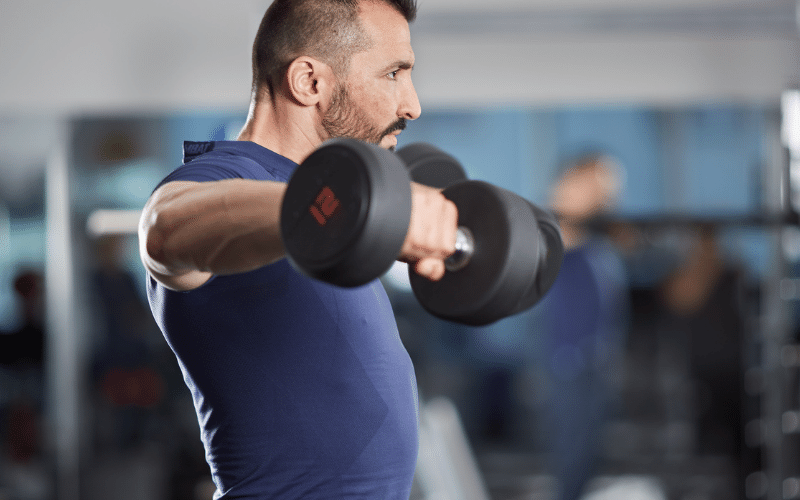Table of Contents
Muscles Worked by The Dumbbell Rear Delt Fly?
The rear delt fly is an isolation exercise that focuses on the posterior (rear) part of the shoulder, specifically the posterior deltoids.
It’s important to note that this movement does not isolate or target the trapezius muscles (the ones you would shrug up when trying to act like a tough guy).
Rear Delt Fly Benefits
The most obvious benefit is to the posterior deltoid. The rear delt fly can help to sculpt this area of your shoulder.
You need to ensure that you train for both size and shape in order to get the most out of your training.
As with many isolation exercises, the rear delt fly is excellent for creating a ‘peak’ in your shoulder region.
By building up the myofibril mass of the posterior deltoid it will allow you to achieve that desired ‘V’ look. It can also be used as an assistance exercise for chest pressing movements.
Main Benefits Are:
1. Improved Posture.
This is one that many don’t think of, but it’s very important to your training. By performing rear delt flys you will improve the strength and development of the postural muscles such as the rhomboids and lower trapezius. This can be a very valuable thing for those who have bad posture or even kyphosis.
2. Stronger Shoulders.
The rear delt fly is part of any solid shoulder workout. The shoulders are often over trained and left vulnerable to injury, this exercise can help to keep them strong and healthy.
3. Improved Shoulder Joint Flexibility.
Many lifters deal with either bursitis or impingement, due to inflexibility in the shoulder. By adding this exercise to your routine, you will not only improve muscular strength but also flexibility around the shoulder joint which can help to prevent future problems.
4. Improved Rotator Cuff Function.
The rotator cuff is a group of muscles that help to stabilize the shoulder. The rear delt fly both strengthens these muscles and their ability to work together in a functional movement pattern.
5. Improved Aesthetics.
As mentioned above, the rear delt fly can help to improve the look of your shoulder muscles. It is often considered an important exercise for those who wish to achieve that desired ‘V’ look.
How To Do the Dumbbell Rear Delt Fly?
As with many exercises, the first thing you need to do is choose the appropriate weight. Since this exercise isolates a single muscle group it’s important to ensure that you don’t use so much weight that other muscles are recruited for assistance.
Once you have chosen the correct weight (which should be challenging but do-able) pick up your dumbbells.
Start with the dumbbells behind your back, palms facing each other, and elbows bent to around 90 degrees.
From here, keep your arms in this position but begin to raise them up until they are parallel to the ground (a bit like an upside down ‘v’).
Note: It’s important not to swing or use momentum for any part of this movement. Your shoulder blades should contract together as you stretch your arms out to the side.
Lower the dumbbells back down using similar form to how you used them on the upward phase, only now your palms will be facing forward.
Make sure that you finish each rep at the starting position (behind your back) to ensure that you have worked the muscles correctly.
Reps, Sets and Rest For The Rear Delt Fly?
It is recommended that you begin with a set of 10-15 repetitions and add a rep or two each week until you can do 20 reps in 1-2 sets.
Once this weight has been achieved you should move up to the next weight and start the process again.
It’s also important to make sure you rest for around 1 minute in between sets to allow your muscles enough time to recoup their strength before you perform another set. This is especially important if you are using heavy weights.
How Often Should The Rear Delt Fly Be Performed?
The rear delt fly can be performed at the end of a shoulder workout to add volume and intensity. Worth noting is the fact that it should not be included in your routine on consecutive days.
Due to the significant stress placed on the shoulders when performing this exercise, you must allow them sufficient time to recover before performing another one.
If you want to include it twice a week then stick to a maximum of 3-4 days between workouts.
It’s also not advised to perform the rear delt fly more frequently than this. Many find that their muscles become very adapt to the movement, and hence it becomes less effective.
Dumbbell Rear Delt Fly Variations?
It is possible to make this exercise more difficult by changing the angle of your body. Placing your feet up on a bench or putting them shoulder width apart will increase the difficulty of the movement.
This may not be necessary for many, but it can be useful if you are looking to improve strength. Particularly if you are close to muscle failure at the current angle.
At the same time, if you are just starting out then it’s important not to try too much variation in your workouts.
Stick with this version for a while until improvement is made If you find the dumbbell rear delt fly difficult at first.
[wp-stealth-ads rows=”2″ mobile-rows=”2″]


